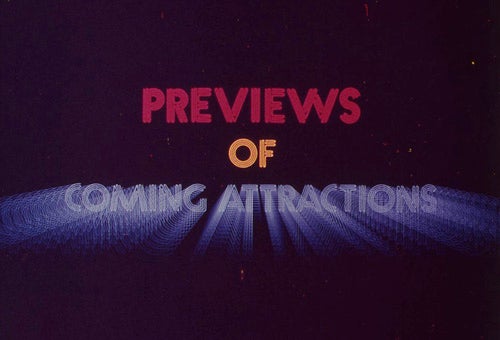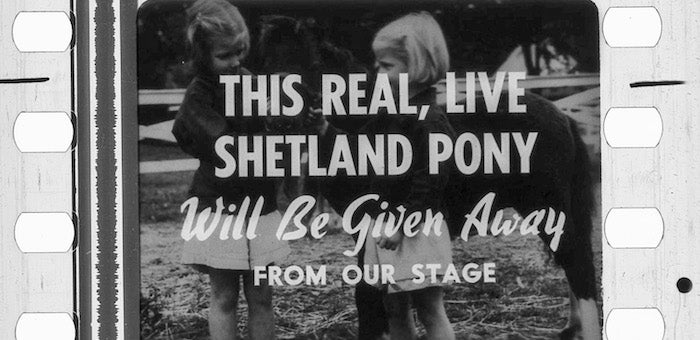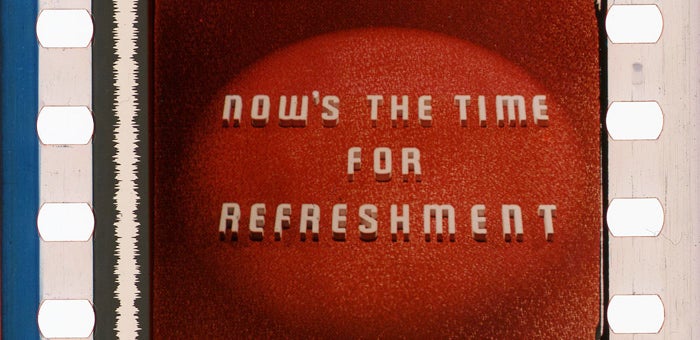
An audience member’s moviegoing experience usually includes more than just a feature film. Film shorts, newsreels, cartoons and trailers have all flickered on screen since theaters began, starting with pre-show glass slides in the early days of movie houses. Another category of celluloid shown in theaters are “snipes,” which include local advertisements, intermission films, theater announcements and policies, and pretty much everything other than the movie itself. Snipes comprise an important piece of cinema history because they document the moviegoing experience and the lifestyles of their time.
The most famous snipe is the 1957 intermission film “Let’s All Go to the Lobby,” featuring dancing concession treats and an unforgettable tune. The film was even noted as a historically and culturally important piece of American film history by the Library of Congress and added to the National Film Registry in 2000.
During the Depression, cinemas used pre-show screen time for contests and special events to draw audiences into seats. One common giveaway during this era was “Dish Night.” Women who attended film screenings would receive a different piece of a dish set each week. Dish nights were followed by bank giveaway nights, where cash prizes were awarded.

Giveaway nights at theaters allowed local businesses to drum up some advertising while also getting patrons into seats. A theater in Lorain, Ohio gave away every kid’s dream pet in 1952. The ad from the Stu Levin Collection announced, “Win a Shetland pony from Mack’s Lazy ‘T’ Ranch Valley City, Ohio through a contest in the Lorain Journal at the Kiddie Show Saturday, August 18th in connection with the showing of Bob Hope in Son of Paleface.”
A collection of snipes like the one the Shetland pony giveaway arrived with is valuable because it paints a picture of what a town was like in the 1950s. Many local stores and events are documented, like the Lavender Lady Beauty Salon, Ed’s Transmission and the Policeman’s Halloween Ball.
There’s no place more associated with snipes than the drive-in. Drive-in attendance boomed in the ‘50s as moviegoers jumped in their cars for a film. Intermission breaks between feature films allowed plenty of time to run snipes that encouraged patrons to head to the snack shack. Films featuring clocks and countdowns helped audiences keep track of their time until the next feature. With many drive-ins now closed due to changing viewing habits, drive-in theater snipes remain great reminders of the drive-in experience, as they outlast the venues where they were exhibited.

UCLA Film & Television Archive contains the collection of UCLA graduate and former professor Robert Abel. Abel founded his own design firm with partner Con Pederson in 1971, named Robert Abel & Associates. The company made many commercials, including the 1981 Atari theater commercial “The Fly.” Robert Abel was a pioneer in computer graphics, so it is no wonder that the Atari Company chose his firm to make a theater commercial for their new gaming system. The two-minute advertisement promotes Atari’s system and the games “Yars’ Revenge,” “Asteroids” and “Star Raiders” and was appropriately played for enthralled audiences before Star Wars Episode VI: Return of the Jedi (1983).
One snipe that has interesting relevance today is the 1970s ad for the “Save Free TV” petition, available for viewing on the Internet Archive. This lobbying campaign was constructed by over-the-air television networks and supported by theater chain owners, who both felt threatened by the arrival of cable. The cartoon refers to pay TV as the monster inside of the television and urges moviegoers to sign a petition persuading lawmakers to “Save Free TV.” This ad continues to resonate in an era in which movie theaters and network television are once again losing audiences, but this time to on-demand internet services like Netflix, Hulu and Amazon.
No matter how our viewing habits change in the future, it’s important to remember that our moving image history encompasses more than just feature films and television programs, and that archives provide a home for this wide spectrum of materials.
– Trisha Lendo
< Back to the Archive Blog






 Mobile Navigation
Mobile Navigation

